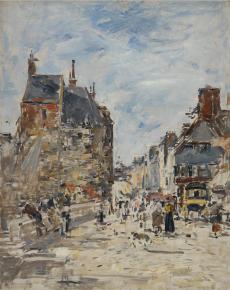


From the outset of his career, Eugène Boudin painted numerous studies from nature. Baudelaire admired his pastels – coloured notations on atmospheric effects – but the artist also used drawings, enhanced with watercolour, or oil sketches, on canvas or paper, particularly in order to capture the memory of human figures. These studies were then worked up into more elaborate compositions. At the end of his career, Boudin increasingly preferred to produce work quickly, which he would then rework very little or not at all in his studio. ‘Three brushstrokes from nature,’ he would say, ‘are worth more than two days of work on an easel.’
Such is the case with this view of Honfleur, Boudin’s hometown, which preserves its former appearance with its picturesque houses and lanes. The building depicted here, a vestige of the ancient fortifications not far from the quay, is called La Lieutenance (it was the residence of the fort’s lieutenant commander) and remains to this day one of the port’s most notable monuments. The nervous, jerky brushstrokes, playing with the viewer’s eye by obliging him to follow the painter’s syncopated vision, make up an ensemble at the limits of abstraction, yet are so evocative of the life and soul of the little fishing port.
By virtue of his anti-conformity and his innate qualities as a colourist, Boudin played a leading role in the history of French painting of the second half of the 19th century. In addition, he was perhaps the first to sense the talent of a young compatriot, Claude Monet. Around 1858, Boudin, amused at the caricatures Monet exhibited in Le Havre, encouraged him to work on landscapes with him en plein air. It was then that the youthful Monet painted his first landscapes and still lifes, which owe much to Boudin’s experience. This influence combined with that of the Dutch landscape artist J. B. Jongkind (1819-1891), who was also working in Le Havre in an independent vein, close to the aspirations of his fellow artists. Monet himself often repeated: ‘I owe to Eugène Boudin the fact that I became a painter’, thus attributing to his benevolent elder a major role in the emergence of Impressionism.
As an apprentice in a shop in Le Havre that supplied art materlias, he becamse acquainted with many well-known painters. Following his art studies in Paris (1851-1854), he returned to Le Havre; many of his workds are landscapes and marine scenes of this harbour town and its surroundings. He was one of the first artists to paint en plain air, and his works emphasise nature, weather conditions and blue skies. He created brightly lit chronicles of contemporary life, particularly at the seaside resorts of Deauville and Trouville. A young Claude Monet was encouraged by him to paint outdoors.